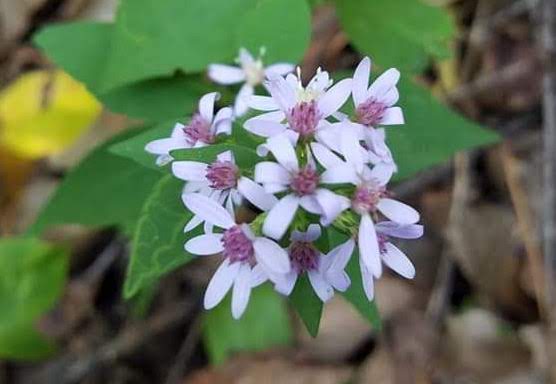Katie Byerly closes out this year’s series of wildflower posts with an aster that blooms in the autumn. You can find her on YouTube at Iowa Prairie Girl. -promoted by Laura Belin
I was walking a narrow, heavily canopied trail at the Lime Creek Nature Center in Mason City when I first noticed Common blue wood aster (Symphyotrichum cordifolium).
Wood asters prefer shady areas, and their size depends on the amount of light they receive. Along this sun-dappled trail the wood aster was adorably small. Wood asters typically reach heights between one and three feet; this one couldn’t have been more than 8 inches high. This little beauty offered a relief of almost hidden blue color to the black trail, lined with green foliage.
I have found that it is difficult to read wildflower field guides if you don’t know the flower terminology. Common blue wood aster is a great flower for terminology study. To begin with, another name for this species is the Heart-leaved aster. The lower leaves are cordate, meaning heart-shaped. The petiole or stalk is another good identifier for common blue wood. It is long and narrow. Typically, the petiole is half to almost as long as the leaf blade.
As the leaves progress up the stem, they become cordate-ovate to just ovate, meaning egg-shaped. Leaves also become smaller further up the stem. Finding an aster in a shady area with heart-shaped leaves is a good indicator that you might have a common blue wood aster.
Another neat botanical word to learn is panicle. A panicle is a loose branching cluster of flowers. In the wood aster, the cluster is longer than it is wide and broader at the bottom than it is at the top. It consists of small half-inch flowerheads that are lavender to light blue in color. Each flowerhead can have between seven and fifteen ray petals or florets.
I do not feel qualified to write about the difference between ray and disk florets. But on that note, the center of the flower is made up of seven to fifteen tiny disk flowers or florets. When the flower first blooms, they are a creamy yellow color.
As the flower matures, they turn a pale purple to reddish purple color.
The last key term to learn is bract, referring to the leaves holding the flower together. Turn the flower over to find the bracts. You can see in the next picture that the wood aster bracts have a dark green, diamond-shaped patch near their tip. Remembering to look at the bract will help you a lot with flower identification.
In this picture, the florets have finished blooming and turned into achenes, defined as a simple dry fruit produced by a flowering plant. I would call them the seeds.
Common wood asters bloom for one to two months. You will start seeing them in August and with luck into October, depending on the weather and your location. Once you learn to identify wood asters, you will start seeing them during many of your fall walks. I have found them along trails in parks, on the edges of woods as well in the middle of the woods. Here’s Prairie Dog behind a patch.
Like all sturdy asters, wood asters may grow in unexpected places, like in town along old parking areas or vacant lots.
Native Americans described asters as “the flower that brings the frost.” As I write, the asters have finished blooming, and winter is upon us. But there is hope for the next blooming season and time for more aster identification studies to work on till then.
More information on common blue wood asters can be found on my YouTube Channel: Iowa Prairie Girl.
Information for this article was found on the Iowa Wildflower App and Illinois Wildflower website.













2 Comments
Another great year for Wildflower Wednesdays, thank you very much
The woodland aster can also serve as a reminder that many Iowa woodlands need help, and so do many woodland wildflowers. We need to make use of what we now know. (I’m old enough to remember when most Midwestern foresters thought all woodland fires were bad. Fortunately, we know better now.)
Before EuroAmericans took over Iowa, fire was a huge regular force shaping Iowa woodlands as well as prairies. Back then, Iowa’s oak savannas and woodlands were more open and allowed more light to reach the woodland floor. Many wildflowers that thrive in dappled shade had far more habitat throughout the woodlands, not just along the edges.
Now many Iowa woodlands suffer from a combination of invasive shady exotic shrubs (Asian bush honeysuckle is one of the worst), fire suppression, and deer overpopulation. Wildflowers suffer as a result, and so do baby oak trees. We need a lot more clearing of invasive brush in our woodlands, and more prescribed fires. But both cost money, and Iowa has less conservation funding than almost any other state.
It would help if Iowa finally provided money for IWILL, the never-funded natural resources fund approved by Iowa voters almost a decade ago. But not if all the money is handed over to farmers to pay for farm conservation (and a valid argument can be made that Iowa farmers should be required to do at least a few basic things for water instead of farm conservation being entirely optional.)
Giving almost all future IWILL money to farmers and leaving nothing for public land and outdoor recreation is exactly what the Iowa Farm Bureau wants. And in the current Legislature, it could happen.
PrairieFan Wed 27 Nov 7:42 PM
I'd welcome a guest commentary on this
if you feel inspired to pull together these thoughts for a separate post.
Laura Belin Thu 28 Nov 11:28 AM